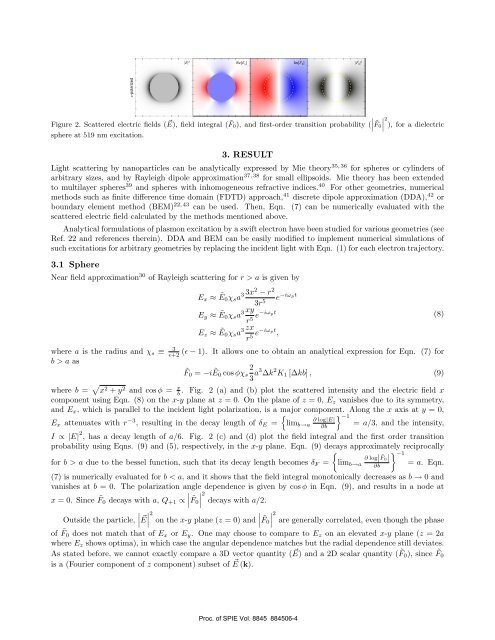Photon-Induced Near Field Electron Microscopy - California Institute ...
Photon-Induced Near Field Electron Microscopy - California Institute ...
Photon-Induced Near Field Electron Microscopy - California Institute ...
You also want an ePaper? Increase the reach of your titles
YUMPU automatically turns print PDFs into web optimized ePapers that Google loves.
|E| 2<br />
Re[E x ] Im[F 0 ]<br />
|F 0 | 2<br />
x-polarized<br />
Figure 2. Scattered electric fields ( E), ⃗ field integral ( ˜F 0), and first-order transition probability ( ˛ ˜F 0˛˛˛2<br />
), for a dielectric<br />
sphere at 519 nm excitation.<br />
3. RESULT<br />
Light scattering by nanoparticles can be analytically expressed by Mie theory 35, 36 for spheres or cylinders of<br />
arbitrary sizes, and by Rayleigh dipole approximation 37, 38 for small ellipsoids. Mie theory has been extended<br />
to multilayer spheres 39 and spheres with inhomogeneous refractive indices. 40 For other geometries, numerical<br />
methods such as finite difference time domain (FDTD) approach, 41 discrete dipole approximation (DDA), 42 or<br />
boundary element method (BEM) 22, 43 can be used. Then, Eqn. (7) can be numerically evaluated with the<br />
scattered electric field calculated by the methods mentioned above.<br />
Analytical formulations of plasmon excitation by a swift electron have been studied for various geometries (see<br />
Ref. 22 and references therein). DDA and BEM can be easily modified to implement numerical simulations of<br />
such excitations for arbitrary geometries by replacing the incident light with Eqn. (1) for each electron trajectory.<br />
3.1 Sphere<br />
<strong>Near</strong> field approximation 30 of Rayleigh scattering for r > a is given by<br />
where a is the radius and χ s ≡ 3<br />
b > a as<br />
ɛ+2<br />
E x ≈ Ẽ0χ s a 3 3x2 − r 2<br />
3r 5<br />
E y ≈ Ẽ0χ s a 3 xy<br />
r 5 e−iωpt<br />
E z ≈ Ẽ0χ s a 3 zx<br />
r 5 e−iωpt ,<br />
e −iωpt<br />
(ɛ − 1). It allows one to obtain an analytical expression for Eqn. (7) for<br />
˜F 0 = −iẼ0 cos φχ s<br />
2<br />
3 a3 ∆k 2 K 1 [∆kb] , (9)<br />
where b = √ x 2 + y 2 and cos φ = x b<br />
. Fig. 2 (a) and (b) plot the scattered intensity and the electric field x<br />
component using Eqn. (8) on the x-y plane at z = 0. On the plane of z = 0, E z vanishes due to its symmetry,<br />
and E x , which is parallel to the incident light polarization, is a major component. Along the x axis at y = 0,<br />
{<br />
E x attenuates with r −3 , resulting in the decay length of δ E =<br />
lim b→a<br />
∂ log|E|<br />
∂b<br />
(8)<br />
} −1<br />
= a/3, and the intensity,<br />
I ∝ |E| 2 , has a decay length of a/6. Fig. 2 (c) and (d) plot the field integral and the first order transition<br />
probability using Eqns. (9) and (5), respectively, in the x-y plane. Eqn. (9) decays approximately reciprocally<br />
{<br />
} −1<br />
∂ log|<br />
for b > a due to the bessel function, such that its decay length becomes δ F = lim ˜F 0|<br />
b→a ∂b<br />
= a. Eqn.<br />
(7) is numerically evaluated for b < a, and it shows that the field integral monotonically decreases as b → 0 and<br />
vanishes at b = 0. The polarization angle dependence is given by cos φ in Eqn. (9), and results in a node at<br />
x = 0. Since ˜F 0 decays with a, Q +1 ∝ ∣ ˜F<br />
∣ ∣∣<br />
2<br />
0 decays with a/2.<br />
Outside the particle, ∣E<br />
⃗ ∣ 2 on the x-y plane (z = 0) and ∣ ˜F<br />
∣ ∣∣<br />
2<br />
0 are generally correlated, even though the phase<br />
of ˜F 0 does not match that of E x or E y . One may choose to compare to E z on an elevated x-y plane (z = 2a<br />
where E z shows optima), in which case the angular dependence matches but the radial dependence still deviates.<br />
As stated before, we cannot exactly compare a 3D vector quantity ( ⃗ E) and a 2D scalar quantity ( ˜F 0 ), since ˜F 0<br />
is a (Fourier component of z component) subset of ⃗ E (k).<br />
Proc. of SPIE Vol. 8845 884506-4
















